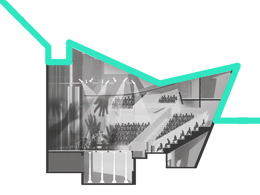STUDENTS PROJECTS
PROJECTS2015

02 August, 2016
On stage | Agras 22
"Theatre" as a word refers both to the theatrical performance as well as the space in which it takes place.
Students: Alysandratou Sofia, Psarra Mikaela
Supervisors: Tsiraki Sofia, Vasilatos Panagiotis
Consulting professors: Karydis Dimitris, Sotiropoulou Alexandra
University: National Technical University of Athens, School of Architecture
Presentation date: 20 July 2015
"Theatre" as a word refers both to the theatrical performance as well as the space in which it takes place. It is the fusion of fiction and reality displaying a diverse historical evolution of various transformations. Starting with the ancient drama of Dionysian worship and reaching modern times through the experimental manifestations of artists, it reflects the society and culture of each era. Nowadays, the dramaturgy extends to other artistic fields under the general term "performing arts" transforming theatre space into a "show room".

The structure of the theatre consists of a wide range of areas supportive of the stage that are organically integrated, such as the entrance hall, foyer and backstage. These areas can be considered as a preparation to the theatrical ritual and a field of infiltration, extending to social space and chiseling interpersonal relationships.


Mets is a neighborhood which combines different city scales enabling the theatre to act as a landmark and a reference point of hyper-local importance. The site of this project is located next to the Panathenaic Stadium, on the hill of Ardittos. Its function indicates a strong social and cultural nature in direct reference to the ancient stadium itself, the Athens Conservatoire, the National Research Foundation, the National Gallery, the New Museum of Contemporary Art of Goulandris Foundation (in construction process) and the Athens Concert Hall located nearby. The hill of Ardittos is considered to be a significant area of unique natural and historic features offering overall sighting of the landscape of Attica from the Lycabettus Hill to the sea. Closely related to the historic center and the commercial triangle it has been widely affected by the transformations and expansion of the city.

Agras street, on which this theatre is located, preserves the atmosphere and serenity of the old Athenian neighbourhood streets despite being in the immediate vicinity of the dense center of Pagrati. The street, formed as a wide curve, became an inspiration for the first designing compositional intentions. The project's concept is based on the idea of two parallel movements, one of which passes through the foyer leading to the centre of the theatre, while the other forms a path that runs through the building reaching the natural landscape.

The latter path leads from the city to the hill through the building's roof being consistent of the materiality and the composing elements of the project. The theatre seeks to achieve the connection and integration with the natural environment by using an architectural vocabulary that designates its function and at the same time reactivates both a recessive urban space and the hill of Ardittos.

The most important structural elements of the theatre that remain unchanged for 2500 years, have been the stage and the auditorium. Their correlation forms a communicational mechanism by creating relations inside a group of spectators, a group of actors-performers and between the actors and the audience. It is apparent, both typologically and chronologically, that the spatial geometries in which an audience interacts with an acting group of artists cannot be infinite, despite the variety of theatres' capacity sizes and shapes or their repertoire. In consideration to this fact, the stage plan of this theatre follows the morphology of the "open scene" which can offer unobstructed viewing from three sides and various opportunities to develop interpersonal relationships. Therefore, a center is created, around which the seats are arranged in a radial layout. This center suggests the performance of a ritual, in which the whole audience participates, just like in the prehistoric period the magician was surrounded by members of the tribe.

The position of the stage contributes to maintain its connection to the backstage area which is a vital but invisible part of the theatrical process. The back end -the "off stage"- is formed on a longitudinal zone across the back of the building, which is accessed directly from the road via a secondary entrance that facilitates the passage and storing of scenography sets. Following this assistive zone, one can find the dressing rooms for the performers and a multipurpose hall used for rehearsals or even cultural events of a smaller scale.











